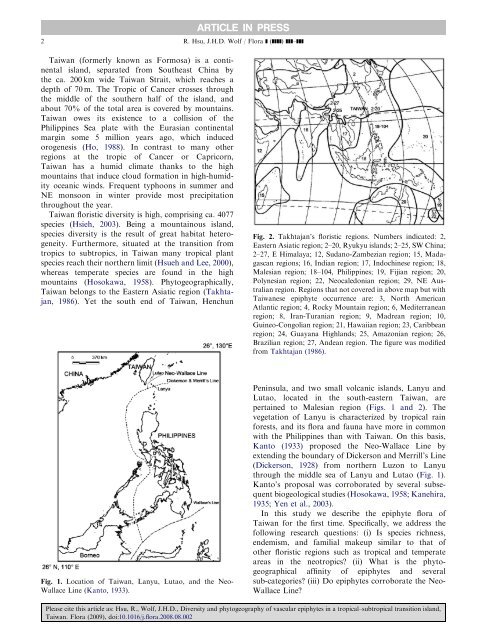Diversity and phytogeography of vascular epiphytes in a tropical ...
Diversity and phytogeography of vascular epiphytes in a tropical ...
Diversity and phytogeography of vascular epiphytes in a tropical ...
Create successful ePaper yourself
Turn your PDF publications into a flip-book with our unique Google optimized e-Paper software.
2<br />
Taiwan (formerly known as Formosa) is a cont<strong>in</strong>ental<br />
isl<strong>and</strong>, separated from Southeast Ch<strong>in</strong>a by<br />
the ca. 200 km wide Taiwan Strait, which reaches a<br />
depth <strong>of</strong> 70 m. The Tropic <strong>of</strong> Cancer crosses through<br />
the middle <strong>of</strong> the southern half <strong>of</strong> the isl<strong>and</strong>, <strong>and</strong><br />
about 70% <strong>of</strong> the total area is covered by mounta<strong>in</strong>s.<br />
Taiwan owes its existence to a collision <strong>of</strong> the<br />
Philipp<strong>in</strong>es Sea plate with the Eurasian cont<strong>in</strong>ental<br />
marg<strong>in</strong> some 5 million years ago, which <strong>in</strong>duced<br />
orogenesis (Ho, 1988). In contrast to many other<br />
regions at the tropic <strong>of</strong> Cancer or Capricorn,<br />
Taiwan has a humid climate thanks to the high<br />
mounta<strong>in</strong>s that <strong>in</strong>duce cloud formation <strong>in</strong> high-humidity<br />
oceanic w<strong>in</strong>ds. Frequent typhoons <strong>in</strong> summer <strong>and</strong><br />
NE monsoon <strong>in</strong> w<strong>in</strong>ter provide most precipitation<br />
throughout the year.<br />
Taiwan floristic diversity is high, compris<strong>in</strong>g ca. 4077<br />
species (Hsieh, 2003). Be<strong>in</strong>g a mounta<strong>in</strong>ous isl<strong>and</strong>,<br />
species diversity is the result <strong>of</strong> great habitat heterogeneity.<br />
Furthermore, situated at the transition from<br />
tropics to subtropics, <strong>in</strong> Taiwan many <strong>tropical</strong> plant<br />
species reach their northern limit (Hsueh <strong>and</strong> Lee, 2000),<br />
whereas temperate species are found <strong>in</strong> the high<br />
mounta<strong>in</strong>s (Hosokawa, 1958). Phytogeographically,<br />
Taiwan belongs to the Eastern Asiatic region (Takhtajan,<br />
1986). Yet the south end <strong>of</strong> Taiwan, Henchun<br />
Fig. 1. Location <strong>of</strong> Taiwan, Lanyu, Lutao, <strong>and</strong> the Neo-<br />
Wallace L<strong>in</strong>e (Kanto, 1933).<br />
ARTICLE IN PRESS<br />
R. Hsu, J.H.D. Wolf / Flora ] (]]]]) ]]]–]]]<br />
Fig. 2. Takhtajan’s floristic regions. Numbers <strong>in</strong>dicated: 2,<br />
Eastern Asiatic region; 2–20, Ryukyu isl<strong>and</strong>s; 2–25, SW Ch<strong>in</strong>a;<br />
2–27, E Himalaya; 12, Sudano-Zambezian region; 15, Madagascan<br />
regions; 16, Indian region; 17, Indoch<strong>in</strong>ese region; 18,<br />
Malesian region; 18–104, Philipp<strong>in</strong>es; 19, Fijian region; 20,<br />
Polynesian region; 22, Neocaledonian region; 29, NE Australian<br />
region. Regions that not covered <strong>in</strong> above map but with<br />
Taiwanese epiphyte occurrence are: 3, North American<br />
Atlantic region; 4, Rocky Mounta<strong>in</strong> region; 6, Mediterranean<br />
region; 8, Iran-Turanian region; 9, Madrean region; 10,<br />
Gu<strong>in</strong>eo-Congolian region; 21, Hawaiian region; 23, Caribbean<br />
region; 24, Guayana Highl<strong>and</strong>s; 25, Amazonian region; 26,<br />
Brazilian region; 27, Andean region. The figure was modified<br />
from Takhtajan (1986).<br />
Pen<strong>in</strong>sula, <strong>and</strong> two small volcanic isl<strong>and</strong>s, Lanyu <strong>and</strong><br />
Lutao, located <strong>in</strong> the south-eastern Taiwan, are<br />
perta<strong>in</strong>ed to Malesian region (Figs. 1 <strong>and</strong> 2). The<br />
vegetation <strong>of</strong> Lanyu is characterized by <strong>tropical</strong> ra<strong>in</strong><br />
forests, <strong>and</strong> its flora <strong>and</strong> fauna have more <strong>in</strong> common<br />
with the Philipp<strong>in</strong>es than with Taiwan. On this basis,<br />
Kanto (1933) proposed the Neo-Wallace L<strong>in</strong>e by<br />
extend<strong>in</strong>g the boundary <strong>of</strong> Dickerson <strong>and</strong> Merrill’s L<strong>in</strong>e<br />
(Dickerson, 1928) from northern Luzon to Lanyu<br />
through the middle sea <strong>of</strong> Lanyu <strong>and</strong> Lutao (Fig. 1).<br />
Kanto’s proposal was corroborated by several subsequent<br />
biogeological studies (Hosokawa, 1958; Kanehira,<br />
1935; Yen et al., 2003).<br />
In this study we describe the epiphyte flora <strong>of</strong><br />
Taiwan for the first time. Specifically, we address the<br />
follow<strong>in</strong>g research questions: (i) Is species richness,<br />
endemism, <strong>and</strong> familial makeup similar to that <strong>of</strong><br />
other floristic regions such as <strong>tropical</strong> <strong>and</strong> temperate<br />
areas <strong>in</strong> the neotropics? (ii) What is the phytogeographical<br />
aff<strong>in</strong>ity <strong>of</strong> <strong>epiphytes</strong> <strong>and</strong> several<br />
sub-categories? (iii) Do <strong>epiphytes</strong> corroborate the Neo-<br />
Wallace L<strong>in</strong>e?<br />
Please cite this article as: Hsu, R., Wolf, J.H.D., <strong>Diversity</strong> <strong>and</strong> <strong>phytogeography</strong> <strong>of</strong> <strong>vascular</strong> <strong>epiphytes</strong> <strong>in</strong> a <strong>tropical</strong>–sub<strong>tropical</strong> transition isl<strong>and</strong>,<br />
Taiwan. Flora (2009), doi:10.1016/j.flora.2008.08.002


